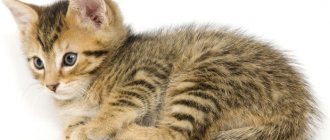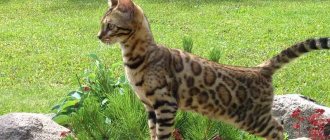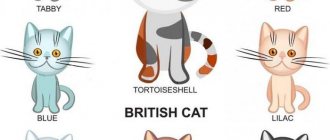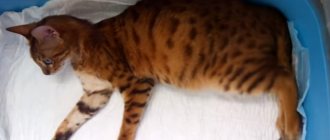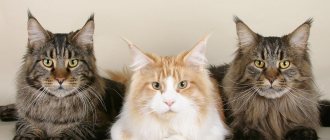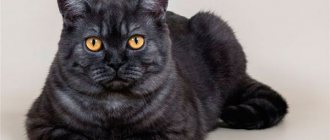Among the short-haired breeds, the snow Bengal cat is considered the most beautiful. The animal has a beautiful physique and a lively, independent character. The peculiarity of the representatives of the breed is their color. It has 3 varieties - sepia, linx and mink, which differ in the shade of the main background and pattern. The future owner of a snow bengal should take into account the subtleties of coloring in order to acquire a real purebred pet.
According to breeders, the Snow Bengal cat can be adopted by people who will devote a lot of time to it, since the animal is very talkative and sociable.
Author
Rudakova Anna
- Vice-President of the World Cat Federation (WCF), expert on all breeds, breeder of Oriental Shorthair, Siamese and Bengal breeds. Experience since 1997.
The Bengal cat breed is one of the most popular in the world. It ranks third after the British Shorthair and Maine Coon. (1)
Bengals are medium to large sized cats known for their richly colored, contrasting coats with bright spots or distinctive marbled patterns. Actually, this is the main distinguishing feature of the breed, for which such cats are most often chosen - as, incidentally, also for their curiosity and loving character. This breed was originally developed by crossing domestic cats and the Asian leopard cat, which is why the Bengal is the only domestic cat that can have rosettes similar to the markings on the skin of the leopard, jaguar and ocelot. Today, the domestic Bengal cat comes only from crossing Bengals with other Bengals.
Bengals tend to be confident, curious, and loyal companions. They get along well not only with other cats, but also with pets in general - it is only important to correctly “introduce” the pets to each other. Bengals love being part of a family. (2)
Each representative of the Bengal breed carries the genes of their ancestors - leopards, therefore Bengals are distinguished by a special head structure (the so-called wild type) and plasticity and grace characteristic exclusively of wild cats. But the main thing is their fantastically beautiful color, for which they are appreciated by numerous fans of the breed. This is beauty given to the Bengal by nature and carefully preserved by the breeders of the breed.
This is a fairly young breed: a little more than half a century has passed since its appearance, but even during this short time the breeders managed to consolidate the phenotype and color.
Health
Bengals are distinguished by enviable health and innate immunity to viral leukemia. This is what got geneticists interested in them. Despite this, a kitten from the nursery must have a complete vaccination card.
When purchasing a Bengal, it makes sense to check the reputation of the breeder. Nurseries that value their name are unlikely to allow a kitten to be sold if it has congenital heart defects or chronic anemia. This is exactly the kind of marriage that is possible with an unscrupulous breeder. This is a consequence of the ban on outcrossing purebred representatives.
In general, a kitten that has all the documents and a confirmed pedigree will not give cause for concern for 14-16 years. With proper care and nutrition, the Bengal's lifespan increases significantly.
Classification Features
The classic color of the Bengal breed is a golden tone of the undercoat with bright rounded spots of various black-brown shades in their most varied variations, from milk chocolate to black. The belly, bleached almost to a platinum hue, is welcome, and this is also a reference to the original origin of Bengals from wild ancestors.
All Bengals are genetically black or blue in color (the bleached black gene in cats), but the shape of the pattern on their coat is extremely varied and varies from spots that look like “polka dots” to fancy round “lambs” and vague “islands” throughout the body of the cat. The pattern can be spotted or marbled; it is important that all elongated fragments are oriented horizontally; tendencies towards the formation of vertical stripes are unacceptable. The spots can have any size and shape, including something as exotic as, for example, “oyster shell” or “butterfly wings.” Complex stains are preferable to simple single ones. It is necessary that each drawing clearly contrasts with the background, is impeccably clear, with clearly, even sharply expressed outlines. There is no special standard for the pattern of spots, there is only a single requirement: the main background of the coat must be extremely clean and uniform, and the pattern must be equally extremely clear. The introduction of such a standard would be pointless, since absolutely every Bengal has its own “own” unique color. Repeating patterns do not exist in nature, clearly demonstrating the boundlessness of her imagination. It is not without reason that all these spots, rosettes, etc. are often compared to human fingerprints - they are just as unique.
A distinctive feature of the Bengal breed is considered not only its amazing color, but also the quality of the fur of these animals. In the short-haired variation of the breed, it is thick and dense; unusually soft and silky to the touch, it creates an indescribable sensation when you touch it. (2)
Types of colors:
- spotted Can be expressed in the form of single spots (single spotted) and rosettes (rosetted);
- marble;
- sparble (sparble from the English marble + spotted, that is, spotted + marble).
rys_-_dmitriy_vahrushev.jpg
Lynx. Photo: Dmitry Vakhrushev
Interesting Facts
- The body length of a male lynx reaches 106 cm, weight – up to 30 kg.
- The lynx is very dexterous: it not only climbs trees and rocks well, but also runs quickly, makes large jumps up to 3.5–4 m, makes long treks, and swims well.
- The objects of lynx hunting are hares, roe deer, musk deer, chamois, aurochs, various birds, rodents, as well as young deer, wild boar, and elk. Hunting through deep snow and crust, the lynx defeats large adult animals.
- The lynx does not touch humans; only a few facts are known that indicate how a wounded lynx attacked people. In her usual state, when meeting a person in the forest, she tries to hide and not show her presence.
- Thanks to the tufts on its ears, the lynx has incredible hearing; it can hear a person’s steps several kilometers away.
Color standards
Coat and color are a distinctive feature of the Bengal cat. The coat of short-haired Bengals is thick and luxurious, close-fitting, unusually soft and silky to the touch. (2) Today there are many colors of this breed, and, depending on the genetic code of the parents, kittens in the same litter can differ significantly from each other.
The color of Bengals is specific and individual for each specific cat of this breed. It features bright, contrasting patterns (spotted and marbled) of black, chocolate, orange or cinnamon on warm backgrounds ranging from golden orange to ivory.
The design may be spotted or marbled, and all its elongated elements should be oriented horizontally, without a tendency towards vertical stripes. The spots can be of any size and shape (for example, an oyster shell, butterfly wings, etc.). Complex stains are preferable to simple single ones. The contrast with the background should be maximum, giving a clear picture with sharp outlines.
Bengals of colorpoint, sepia and mink colors have an ivory-colored body, with a fairly clear (rosette or marble) pattern of brown tone (different shades) along the body. Black Silver Bengals have a light, almost white undercoat and a dark gray or black pattern along the body.
Spotted color
The spotted color (from the English spotted) of the Bengal cat is most often found in the breed, while the spots can be of different sizes and shapes, the only important thing is the direction of their location: strictly horizontally, without “edges” of the pattern along the body. The main color is brown, absolutely any shades of this tone are possible, the only condition is purity and uniformity of tone.
Single Spotted
This variety of spotted color is characterized by a light body tone, while any of the brown shades is allowed. The spots are bright, dark, extremely clearly edged, located only horizontally on the body. The formation of a vertical pattern is not allowed, as well as the effect of creating uniform stripes.
Rosette
Rosettes are large spots of a round or oval shape, and they can be made up of patterns of two or three tones, necessarily sharply contrasting with the main tone of the body. The specificity of this type of spots is that they are darker along the contour of the figure and much lighter towards the center.
Content
Having chosen a snow-white, blue-eyed, beautiful pet for yourself, you need to provide him with appropriate care. And although they are completely unpretentious, you will still need to watch them, especially if it is a small kitten. When you bring your baby into the house, you don’t need to constantly hold him in your arms or play with him. He just needs to be left alone and allowed to get used to his new surroundings. If there are several rooms in a house or apartment, then you need to limit yourself to only one so that the kitten begins to gradually get used to it.
Types of sockets
Rosettes can vary both in size: from very small (“polka dots”) to quite large – and in shape. Below are the three most important types identified by specialists in breeding the Bengal breed.
Arrowhead sockets
This is not the most common rosette shape, but it is the easiest to identify. The shape of such spots can be called conventionally triangular, since it resembles an arrowhead or a drop. The arrow-shaped spots on the coat create the illusion of movement or blur in movement, which has given the Bengal a reputation as a special, “mystical” breed. The Bengal breed standard requires that the spots be located exclusively horizontally; this distinguishes this type of color from the classic tabby, where the pattern follows the “ribs” of the cat.
Paw-print rosettes
A spot similar to an animal paw print: the circumference of the rosette is clearly defined, with dark spots present along the contour of the circle in the form of small strokes. The circuit of such a socket never forms a ring, that is, it does not completely close.
Donut outlets
The prototype and inspiration for this color feature in Bengals is the jaguar, and the spots on the cats’ fur actually resemble donuts. The donut rosette is formed by darker shades along the contour (and there should be at least two such shades), as well as a light center. This rosette is one of the most common forms.
Some other types of sockets should also be described.
Smoked sockets (Clouded)
Large, full, they visually resemble a puzzle piece with a small gap between the spots. The edges of the rosettes should be sharp and clear, and the contrast between them and the main tone of the coat should be as pronounced as possible. The ideal pattern of this kind of rosettes can be observed in nature: the clouded leopard (Neofelis nebulosa) is distinguished by it.
Chain sockets
A chain of interconnected donut rosettes that are connected horizontally and run parallel on either side of the cat's spine. The outline of such outlets should be very clear and bright; each of them must contain at least two different shades. They should stand out sharply against a very light and necessarily uniform tone of the main background of the coat. An example of a chain rosette in the wild is the coloration of ocelots.
Cluster sockets
Clusters are clusters, that is, collections of rosettes, or small spots, grouped around a center, which is always distinguished by a lighter shade. Cluster rosettes may not have a clear closed circle, but rather a cluster of small, shallow rosettes around a light center. The main difference between a cluster pattern and the paw print rosette variant is that the cluster dots surround a light spot in the shape of a cluster, while in a paw print pattern the pattern points are offset to one side, leaving the other side open. In nature, an example of a cluster rosette is the pattern of leopard fur.
Merged sockets
Marble color
The marbled pattern of Bengals consists of various horizontal swirling stripes and a kind of “island” on the coat. The drawing must be positioned exclusively horizontally and have a smooth appearance. In addition, it should be asymmetrical and create a feeling of randomness.
The merle color consists of curls and forms a pattern that cannot be found in any other breed. The main color of the coat should be pure; the contrast with the base color should be as strong as possible, with clear markings with clear edges. The marking is two-color, having a horizontal or diagonal direction. Symmetry of the side pattern is not required. There should be no resemblance to the classic tabby pattern, and a circular or bullseye pattern is not desirable. The more random the pattern looks, the better. Additional color tones within the design are desirable, giving a “stained glass” effect. Patterned markings on the shoulders and colorful markings on the legs and tail are desirable. Rosettes and spots may be present, especially on the legs. The color of the chest and belly should be lighter than the main color, and the pattern should also be located on the belly. Circular or vertical marks are considered defects. It is especially highly valued when the marbled color of the Bengal is formed by three colors: the background shade, the pattern itself and its edging. (3)
This type of color develops slowly: the process is completed only when the cat is two years old.
Color Sparble
The Sparble color is a combination of spotted and marbled patterns. The body color is light and monochromatic. The pattern is a darker shade, horizontal, and combines a marbling pattern that is fused with spots of varying sizes throughout the body and limbs.
Phasing in Bengal kittens
The spectacular color characteristic of Bengals does not appear immediately after birth. The pattern on a kitten's fur is unknown even at the time of moving to a new home. The babies are covered with thin hairs of a white, gray or red hue with a non-distinctive pattern. Up to a year, a Bengal cat can resemble a simple yard striper.
The phasing effect confuses buyers, because at the time of purchase the main qualities of the breed are hidden and you can only trust the reputation of the breeder.
The kitten's bright appearance is hidden due to phasing, which serves as a natural camouflage. The baby's coat begins to change at the age of 12-15 weeks, and ends no earlier than 7 months. The lighter the background of the coat, the sooner the camouflage disappears, while dark merle colors appear slowly. However, watching your pet grow brings pleasure, as the Bengal is transforming every day. By the age of 2, the beauty of a purebred Bengal cat is fully revealed.
Standard colors of Bengals
Standard colors of Bengals include:
- brown (golden) (n 24, n 22);
- snowy (n 24 33, n 24 32, n 24 31, n 22 33, n 22 32, n 22 31);
- silver (ns 24, ns 22).
Brown color
From a genetic point of view, the traditional brown color of Bengals is actually black. Cats of this color are distinguished by the fact that the background color of their coat has many variations from gray-brown to bright orange, almost golden; the color of the spots, rosettes or marbles also varies: from black to light brown or reddish brown. The rules allow all shades of brown. The tail is brown with a black tip, pink nose, brown, copper, gold, green or brown eyes. A white (bleached) belly is preferred; a spot on it is required.
The brown spotted tabby color was recognized in championship status (TICA) in 1991.
Snow color
The “snow bengal” color, in fact, is formed by three genetically different colors - snow Sepia, snow Lynx, snow Mink. Determining the difference between these three colors can be quite difficult, so the best method for differentiating them is a genetic test. If such analysis is not possible, the Snow Bengal's color variant is usually determined by the color of its eyes.
So, Snowy Sepia
(color genes Cb, Cb) has green or gold eyes. The main color of the coat is ivory or cream; shades of pattern - from light coffee to dark; dark tip of the tail.
Snow Links
(color genes Cs, Cs) – only blue eyes. In addition, the variation is distinguished by a very light shade - white, cream or light tan, both dark and light patterns and a dark tail tip.
Snow Mink
(color genes Cb, Cs) – green-blue or aquamarine eyes, ivory, cream or light tan coat; shades of marking - from light beige to dark beige or coffee; dark tip of the tail.
Silver color
Silver (I, I inhibitory genes) is, essentially, not really a color - rather, it is a disadvantage of it. The gene responsible for its formation blocks out any warm colors and creates an almost white background, clearly contrasting with the bright dark markings. Silver Bengal cats come in a variety of shades with backgrounds ranging from white to a very dark, steely color.
Silver is also included in other color combinations: “Silver Snow”, “Coal on Silver”, “Blue Silver”, etc. In general, a silver sparkler has:
- less yellow and brown tint in the base color;
- pattern from dark gray to black;
- black tip of tail;
- brick red nose;
- green or golden eyes.
The silver color was added to the TICA Championship for the Bengal breed in 2004.
What to feed?
The feeding process is very important in caring for a kitten. Special dry food is more suitable for Snow Bengal cats. They contain all the necessary beneficial vitamins and minerals that pets need. In addition, they will not cause any harm to the teeth or gums of cats. You can purchase food in specialized stores. Such cats eat with great pleasure, but you still need to make sure that they do not overeat. After all, this can even lead to obesity.
Therefore, they should be fed no more than 4 times a day, and the portions should not be too large.
It is also necessary to give your pets plenty of water to prevent urolithiasis . If your cat drinks very little, you can purchase special drinking bowls that have miniature fountains. This will immediately attract the attention of animals. However, cats of this breed love to swim, so they can playfully even turn over a bowl of water.
Rare colors (unrecognized colors)
Many felinological systems still do not recognize several specific Bengal colors, in particular, charcoal (charcoal), blue and melanistic (black).
Carbonic
The Charcoal Bengal (Apb or Apb, Apb color genes) is darker than the recognized colors. The black, smoky charcoal color was especially noticeable in the early generations of F1 and F2 Bengals. The Charkoal trait is inherited regardless of the color of the animal and can be exhibited in each color class: brown, silver, snow (Lynx charkoal, Mink charkoal, Sepia charkoal) and blue.
Charcoal Bengals are distinguished by a dark gray or black (charcoal) background with small, very dark spotted or marbling patterns, which should never be red. (4) The Charkoal may also have a darker mask on its face and a thick stripe, commonly called the "Zorro mask" - which resembles an upside-down Y.
This mask can be very dark, the same color as the black body markings. The tail of such a cat is dark brown, black or gray-black with stripes and a black tip.
Blue
Blue color (d, d diluted genes) is perhaps the rarest among Bengal colors. Since the gene responsible for this color is recessive, a blue Bengal cat can only be born from a pair in which both parents carry a blue color in the genotype.
Some breeders are making every effort to try to promote this undoubtedly beautiful variation of Bengals to recognition, and today this color is already recognized by two systems - CFA and WOC.
Blue Bengal cats are distinguished by their gray-blue color with the presence of cream tones. Mottled or marbled pattern - dark blue or metallic grey. The base coat color of the Blue Bengal is pale bluish-gray to gray-blue with markings ranging from medium blue to dark blue. As a general rule, the base color and markings should contrast markedly with each other. Warm fawn tones may be present on the cat's face, back and legs. The underside and chest are a lighter shade from the main body color, as are the areas around the eyes, temples and muzzle. The pigment around the eyes and lips is dark blue. The skin of the nose is pink, with a dark blue outline. Paw pads are eggplant color (purple). Eye color can be any, except blue. (3)
Black
The term "melanistic" when describing cats means "solid color." The melanistic Bengal cat has visible markings along the body: this is commonly called the “ghost tabby color”. The black (melanistic) Bengal cat (color genes a, a) actually has black patterns on a black background that are reminiscent of the melanistic color variant of leopards and jaguars - the legendary black panther.
The melanistic Bengal's background and pattern colors are the same, ranging from dark brown to black, and their patterns are subtle and are commonly referred to as "ghost markings" or "ghost spots." But the pattern can still be seen in daylight - like on a black panther. The pattern is also more noticeable in kittens.
Black Bengals are extremely rare and less popular among breeders because these color variations are not recognized by most feline systems.
It is also worth noting the smoky Bengal - this is a silver variation of the melanistic color.
rys-dmitriy-vahrushev.jpg
Lynx.
Photo: Dmitry Vakhrushev In 2012, the Russian Geographical Society grant project “In the Footsteps of the Snow Leopard” grew into a full-scale project “Wild Cats of Southern Siberia” for the study and conservation of rare cat species of southern Siberia - snow leopard (irbis), manula and lynx. The project is aimed at increasing the effectiveness of environmental protection measures in specially protected natural areas of Southern Siberia - these are the Khakass and Sayano-Shushensky nature reserves, the Ubsunurskaya Kotlovina state nature reserve and the Pozarym state nature reserve of federal significance. Among the objectives of the project are studying nutrition, monitoring the food supply and conducting a zoological and veterinary examination of natural populations of wild cats, as well as increasing the level of public knowledge about the need and importance of preserving rare species of animals.
Author: Anna Sokolova
Coat and colors of long-haired Bengals (Cashmere)
Initially, the gene for long hair was considered an undesirable trait in the breed, but at the moment long-haired Bengals (Kashmirs) are already recognized by some international felinological systems.
The legitimacy of distinguishing Kashmir cats from the total number of Bengal cats has become a goal of many catteries. Breeders in the United States were keen to have these cats recognized as a variety of the Bengal breed due to their long hair - perhaps this is why TICA calls the breed Bengal Longhair. European breeders are trying to give Cashmere cats the status of a new, separate breed. So far, the term “Kashmir” is not widely used and is used mainly among specialists. At the same time, such cats are becoming increasingly popular; there are already nurseries of this breed in the USA, Europe (Germany, Poland, England), and Russia. In 2022, the first system to recognize long-haired Bengals as a separate breed was TICA. Today, Cashmere cats can take part in championships in the TICA, WOC, CFA, WCF systems.
Wool texture
Cashmere Bengals are a natural variation, so one cannot yet expect a uniform coat structure and length from its representatives. The length can be like that of a Turkish Angora cat or like that of a Maine Coon. But, unlike them, Kashmiris have no or almost no undercoat; their wool is closer in quality to the hair of a Bengal cat than to the wool of other long-haired breeds. The hairs are very thin, smooth, soft, pleasant to the touch - like cashmere fiber. This is where the name of the breed comes from - cashmere, which is preferred by breeders. In general, the quality of Kashmiri wool is the same as that of short-haired Bengals, the only difference being the length. This coat is easy to care for. Some believe that Kashmiri wool sheds less and is even hypoallergenic. This topic has not yet been fully studied, but definitely the molting period in these cats is almost invisible.
Colors
Long-haired Bengals have all the same colors as short-haired ones, including even the charcoal group. However, the Kashmiri does not have glitter, and the glitter is in no way related to the length of the coat: the kitten inherits this trait from its parents. The breeder’s task in this case is to select the appropriate pair.
In pattern, Cashmere cats are as beautiful and varied as short-haired Bengals. Their coats can be spotted or rosetted, or marbled, with dark curls contrasting with their light, silky fur.
How to tell if a kitten is Kashmiri
As adults, Kashmiris and Bengals are easy to distinguish from each other, but in infancy this is not always easy. When a litter is born, it is difficult to say which of the kittens will become long-haired if among the parents there is at least one short-haired one who carries the long-haired trait. And even if both parents are Bengals and carry the recessive gene for long hair, it is difficult to predict what their kittens' coat will look like. Most often, in one litter there are kittens with different hair lengths. Typically, the first signs of long hair appear between 4 and 12 weeks of age: you may see “pants” on the hind legs or long hairs in the ears.
Origin story
Domestic Bengal cats owe their origin to humans. The destruction of their wild relatives because of their beautiful fur, resembling a leopard in color, became the impetus for the creation of purebred purebred lines capable of preserving all the characteristics of the species.
Only adult cats were exterminated. Bengal kittens, due to such a feature as phasing (the presence of long protective hair over the main coat), became objects of trade and were presented to tourists as living souvenirs.
The selection was carried out by Jean Mill, who visited Southeast Asia in 1961 and was imbued with the tragedy of the situation. The wild Bengal cat Malaysia, who found an owner in Jean, came with her to America, but for a number of reasons never became the founder of a new breed. Malaysia has clearly demonstrated the possibility of interbreeding with domestic cats and the ability to produce viable and, most importantly, fertile offspring.
Work on creating a new breed of cats continued in the 80s with the support of geneticists and as part of serious research. The case of Malaysia was continued by the Bengal cat Deli and several dozen first-generation hybrid cats.
The selection of domestic Bengals lasted until the end of the 20th century. and was complicated by genetic characteristics. The first three generations of hybrid cats were practically sterile. The offspring of cats inherited the behavioral characteristics of their wild ancestors. Only the fourth generation of Bengals were fully fertile and qualified to be pets. Behavioral selection has reinforced the peacefulness of cats.
The new breed absorbed the blood of the British, Abyssinians, Burmese, Egyptian Mau, Persians, numerous aboriginal shorthairs and became a real treasure among domestic cats. Since 1998, Bengal cats have been recognized by all major felinological associations.
Feeding wild cats
This animal hunts artiodactyls: roe deer, deer and wild boar. Occasionally catches gophers, pikas or small birds. It eats plants in addition to meat food only in the warm season. To get food, the snow leopard jumps onto its prey from a stone, crushing it with its body weight. The leopard jumps 6 meters in length and up to 3 meters in height. He does not begin to eat the killed animal, but drags it to a secluded place. He eats a couple of kilograms of meat at a time, and what he doesn’t finish, he leaves and doesn’t fit into the leftovers anymore.

